This site uses only a few technical cookies necessary for its operation. By continuing to browse, you accept their use.
To find out more...
To find out more...
Don't throw away your pizza crusts
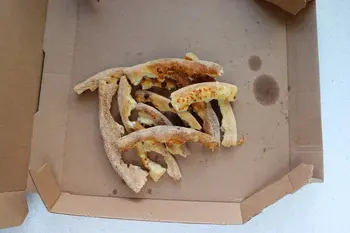
You've probably already noticed that at the end of a pizza meal, at least half of the participants have left the crusts in the boxes or on the plates that many don't eat.
Naturally, one would tend to put them "to the birds", or worse, to throw them away, and it's a shame because they are in fact reusable.
Naturally, one would tend to put them "to the birds", or worse, to throw them away, and it's a shame because they are in fact reusable.
9,897 4.9/5 (17 reviews)
Keywords for this post:PizzaCroutonsRecoveryLeftoversRecycleLast modified on: April 22th 2023
Don't throw away your pizza crusts
These pizza crusts are in fact pieces of cooked pizza dough, which are often, at least partially, "flavored", meaning that there is a little bit of cheese, herbs, tomato sauce, toppings or even all of these at the same time.
So they have a lot of taste, which makes it a shame to throw them away!
Well, at the same time if we don't throw them away, we tend to put them aside, and a few days in the fridge can easily dry them out.
So to reuse them, it is better to cut them in small pieces first.
Then put them in a frying pan in a base of olive oil (for example)...
... and grill them to your taste.
You can then use them a bit like simple croutons, but they will be much better!
Like in this simple raw beet salad, or to replace bread in a panzanella.
To sum up: Don't throw away pizza croutons, but rather grill them and use them as delicious croutons.
So they have a lot of taste, which makes it a shame to throw them away!
Well, at the same time if we don't throw them away, we tend to put them aside, and a few days in the fridge can easily dry them out.
So to reuse them, it is better to cut them in small pieces first.
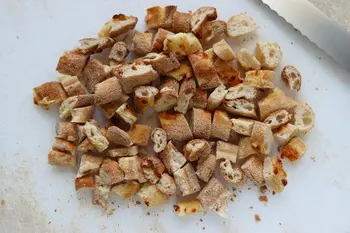
Then put them in a frying pan in a base of olive oil (for example)...
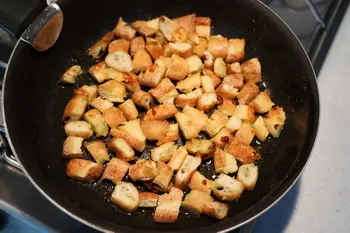
... and grill them to your taste.
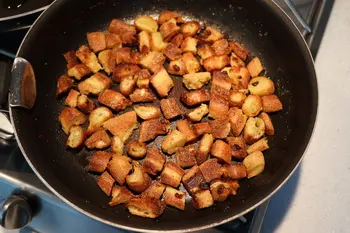
You can then use them a bit like simple croutons, but they will be much better!
Like in this simple raw beet salad, or to replace bread in a panzanella.
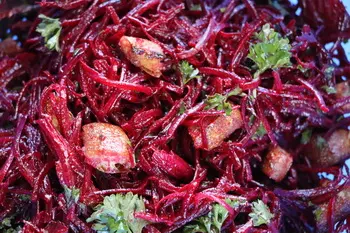
To sum up: Don't throw away pizza croutons, but rather grill them and use them as delicious croutons.
Lasts posts
Butter vs. grease
We often read in a recipe where a pastry is put into a mould that, just before pouring, the mould should be buttered or greased. But what's the difference between these 2 terms?December 1st 20251,0065
Getting out of the fridge early
Very often when you're cooking, you need to take food or preparations out of the fridge, to use them in the recipe in progress. There's nothing tricky about this: you just take them out of the fridge and use them, usually immediately, in the recipe. But is this really a good method?November 24th 20251,1335
Who's making the croissants?
When you look at a bakery from the outside, you naturally think that in the bakery, the bakers make the bread, and in the laboratory, the pastry chefs make the cakes. It's very often like that, with each of these professions having quite different ways of working, but sometimes there's also one...November 23th 20251,022
Oven height
When we put a dish or cake in the oven, we naturally tend to put it on the middle shelf, and that's what we usually do. But in some cases, this position and height can be a little tricky, so let's find out why.October 8th 20252,7765
The importance of sieving
In recipes that use a fine powder (flour, powdered sugar, etc.), you'll often see the advice to sift before using it. To sift is to pass the powder in question through a sieve (a very fine strainer) before incorporating it into your recipe. It's often advice, but is it really useful?September 3rd 20257,5433
Other pages you may also like
Tranché, dissociated, failed, in short... missed!
When preparing a sauce or a cream, there's always a (small) risk that the creamy preparation you're working on will suddenly separate into two parts of different textures: a liquid part, for example, and a more or less solid part, or even become lumpy. It's terribly frustrating, but we'll see...June 19th 202313 K5
Drawing a pattern in pastry
Often in the kitchen, in pastry-making, or in baking, we need to trace a pattern on a pastry. It's just a question of aesthetics but it has its effect after baking on a galette, pithiviers, pâté en croute (terrine in a pie crust), etc.May 23th 201935 K4.1
Cleaning endives
If you buy your endives elsewhere than in supermarkets, and in this case the best is of course from a market gardener, he or she is the one who planted and harvested them, in this case you will have endives full of earth or sand, depending on where they were grown, which is normal and reassuring, we...March 24th 202026 K4.6
The so-called "nervous" meats
You've probably heard this before, we're talking about "nervous" meat, or meat with nerves, to describe what is indicated by the blue arrow on the left. This is a piece of beef, and what we call a nerve is not a nerve, it is in fact collagen (chemists sometimes call it a "collagen sink"), a...April 16th 202137 K4.5
Fruits which can ruin your jelly
There are many ways of making a fruit mousse, but one of the simplest is to prepare a fruit jelly (basically a fresh fruit coulis with gelatine) and then mix this jelly before it sets completely with whipped cream. The result is perfect for filling a charlotte, for example. But do beware;...March 6th 201378 K4.0
Post a comment or question
Follow this page
If you are interested in this page, you can "follow" it, by entering your email address here. You will then receive a notification immediately each time the page is modified or a new comment is added. Please note that you will need to confirm this following.
Note: We'll never share your e-mail address with anyone else.
Alternatively: you can subscribe to the mailing list of cooling-ez.com , you will receive a e-mail for each new recipe published on the site.









